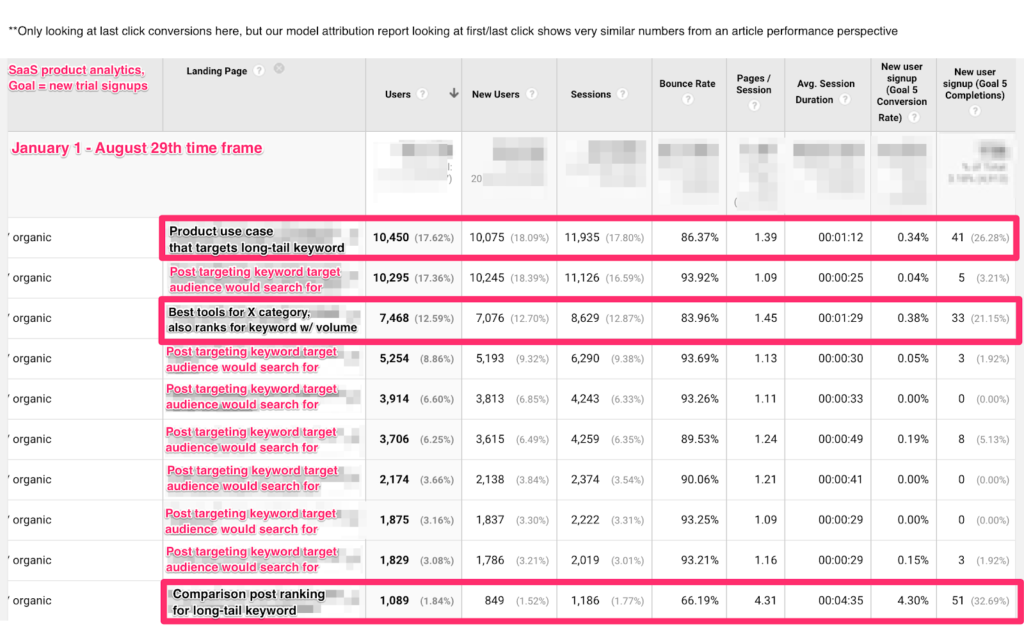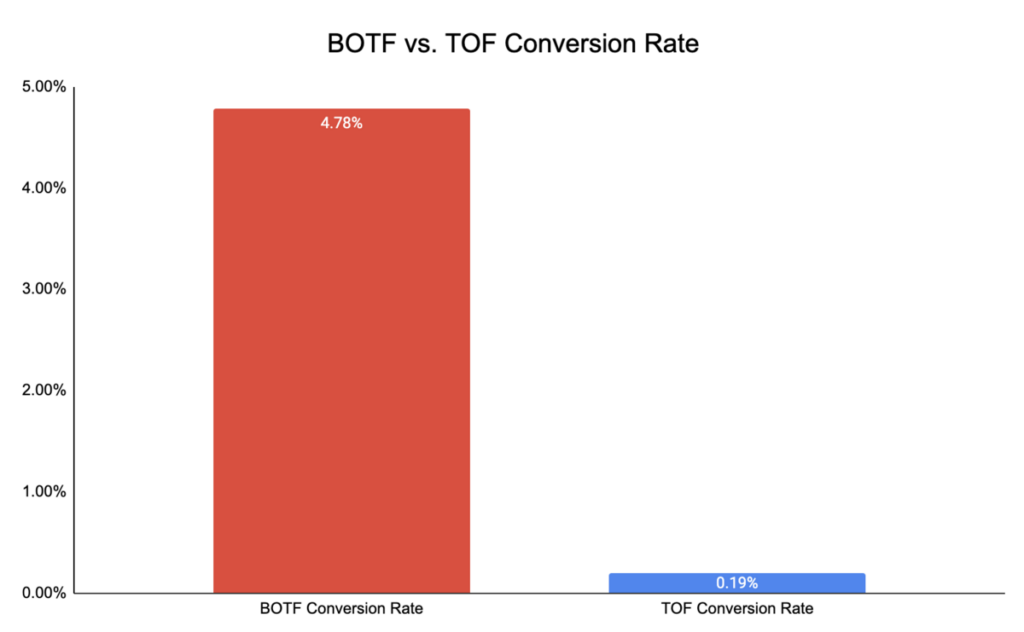We recently noticed that there is a term people are using called “conversion content”. From what we can gather, this refers to content aimed at generating conversions (free trials, demo signups, sales form fills, actual sales), as opposed to how many marketers view content: as a top of funnel, non-converting marketing tactic.
We have, for those familiar with Grow and Convert, built our entire business on using content to generate conversions. So, we have lots of opinions and ideas on this topic, which this article will review.
To start, we noticed that most discussions about creating conversion content place too much emphasis on what we think of as the “window dressing” of content. For example, writing great headlines, having easy-to-read formatting, using compelling visuals, etc.
All of these tips are fine, don’t get us wrong, but they’re, (a) kind of obvious (of course you should have good formatting), and (b) not that important. We’ve had plenty of clients come to us with all of these bases covered — good headlines, clean blog design, good user experience — and yet, their content barely converts.
Why? Because in our experience, these UX details aren’t nearly as important as, (1) the topic and SEO keywords that your content ranks for, and (2) how well you sell your product or service in the content.
You can think of the important aspects of getting conversions from content in three tiers:
- Tier #1 — Topics: Choosing high-converting SEO keywords
- Tier #2 — Writing: Selling your product or service inside the content
- Tier #3 — CTAs and Everything Else: CTAs, headlines, blog design, etc.
Crucially, these tiers are in order of importance. If you don’t take care of tiers 1 and 2 first, then no amount of tier 3 tactics (well crafted headlines, banner CTAs, or CRO “hacks”) will make your content convert.
Below, we’re going to walk through the framework we use to create high-converting content for our clients, including what to know about each tier, why the order is so important, and links to articles that will help you with executing this conversion-focused content marketing strategy.
Note: This post focuses specifically on creating conversion content for SEO because this is what we do at Grow and Convert. We’re not talking about content for social media, video, or other channels, because SEO content is more evergreen and can drive traffic and conversions more sustainably over the long term, making it one of the most valuable forms of conversion content for many businesses. You can learn more about our approach here.
Tier #1 — Topics: Choosing High-Converting SEO Keywords
As we’ve discussed at length many times before, most businesses, content marketing and SEO agencies, and in-house marketers use traffic-focused content strategies. These strategies are based on the assumption that with enough traffic, conversions will inevitably follow.
In practice, this means they prioritize keywords that have high search volume, but low to zero buying intent. For example, if you sell project management software, this might mean targeting keywords such as “project management tips” or “top trends in project management.”
While these keywords are loosely related to your product and likely have high search volumes that could drive substantial organic traffic, people searching these terms show no indication that they have intent to buy project management software. (If they did, they’d be more likely to Google a term with clear buying intent such as “best project management software” or “project management apps for contractors.”)
As a result, from our measurements, these keywords tend to have very low conversion rates — a point that is neatly summarized in this analytics screenshot from our article on Pain Point SEO (our agency’s foundational SEO strategy):

The right most column shows new user signups for each of the URLs listed. The three boxed posts follow the Pain Point SEO approach and rank for keywords with high buying intent. The rest rank for something the target audience could search for, but not a high buying intent keyword. The new user signups from the three Pain Point SEO posts are hundreds of percent higher.
We also showed this at a larger scale in an analysis of 60+ posts for our client Geekbot:

The posts targeting high buying intent keywords (which we’ve traditionally referred to as “bottom of funnel”) didn’t just convert a bit better than the higher-volume-lower-intent posts, they converted 2400% better. In that case study, you can read about how that difference in conversion rate more than made up for any differences in search volume or traffic between the two buckets.
If you choose and rank for the high buying intent keywords, you could get everything else we discuss below wrong and still convert more readers than if you were to get all of what we discuss below right, but focus on keywords that lack buying intent.
This is why choosing the right keywords is the #1 most important thing to get right if you want to increase conversions from content. For an in-depth look at our process for developing a conversion-focused keyword strategy, check out these articles:
- SEO Keyword Strategy: How to Prioritize Based on Buying Intent to Drive More Conversions
- How to Create a Successful SEO Content Strategy: 2 Factors That Are Often Overlooked
Tier #2 — Writing: Selling Your Product or Service inside the Content
Many content marketers barely discuss the company’s product or service inside of the content they write. They’ll sometimes glancingly mention and link to a product or service page in their blog content, but they often just rely on design elements of the page to “take care of conversions” (e.g. pop-ups, email list opt-in forms, CTA graphics, etc.).
We think this mistake is related to the problem discussed in Tier #1 above: that the culture of content marketing has been to keep everything top of funnel (whitepapers, infographics, ultimate guides, etc.). The advice that’s typically paired with that practice is to “not be too salesy” in your content: “just give the customer advice and value and they’ll like your brand and (fingers crossed) remember you later when they need to buy” (not likely).
In our experience, even if you’re writing about top of funnel topics that aren’t product-focused, you need to weave in a compelling discussion of your product or service if you want your content to convert.
Furthermore, if you focus on high buying intent keywords as we discussed above, this necessitates discussing your product or service in order to meet search intent (a key ranking factor in search engine optimization that determines whether or not your content will rank for its intended keyword).
If someone is searching for “best project management software”, their intent is to learn about the details of various options. They want to know what’s better about this software option versus that one, how they compare, which is better for whom, and more. Discussing those product related ideas isn’t “being salesy” for this search query, it’s just fulfilling search intent! So, whether you go after that keyword with a landing page or a blog post, the content of the page needs to discuss your product or service in-depth.
Now, with all of this in mind, there are two key things to consider:
- Writing about product and service details and differentiators requires that writers are able to gain product and domain expertise, and express that through content.
- Expressing originality through content (a key aspect of driving conversions) requires a slightly different approach when selling a service versus a product.
Let’s look at each.
(1) Conversion Content Requires a Process to Gain and Express Product and Domain Expertise
Writing conversion-focused content requires writers to be able to deeply understand your value propositions, key features and unique differentiators, and express these in a clear and compelling way through content.
We can say from experience that this is a unique skill set that isn’t easy to find or teach. Even great writers often lack these key abilities that are more akin to product copywriting. And from what we’ve learned, most content marketing and SEO agencies (many of whom outsource content writing to freelancers) also lack good processes for gaining and expressing product and domain expertise.
At Grow and Convert, because our focus is on ranking for high buying intent keywords (“best accounting software” or “recruiter for executive assistant” for example), we sell our client’s products and services in every piece of content we produce. We get into the details of features, explain how they solve customer pain points, weave in testimonials and case studies, and differentiate our client’s products from those of their competitors.
We do this by basing our articles on extensive interviews with people at our clients’ companies — product teams, sales teams, customer support teams, etc. We have been doing this for years and have an extensive writer training process that has helped us build a tight-knit team of product copywriters.
If you want to write truly high-quality content that is capable of converting readers (particularly advanced B2B readers), involving the experts at your company in your content creation process is absolutely essential.
To learn more about the details of how we approach this, check out these past articles:
- How to do B2B Content Marketing without Domain Expertise
- SEO Content Writing: A 5-Step Process You Can Follow
(2) Expressing Originality Through Content Is Different When Selling a Service versus a Product
What we’ve discussed above — the need to gain product and domain expertise, discuss your unique differentiators, and the way you solve customer pain points — applies to both product and service businesses.
However, another key aspect of conversion content is expressing originality, and in our experience this is done slightly differently depending on whether you sell a product or a service.
If you sell a product, originality comes from discussing your product’s features and the way they solve customer pain points differently or better than your competitors. But if you sell a service, typically the way you express originality comes from discussing what’s different about your strategy or process compared to competitors, and how that allows you to get better results for your clients. We do this in every piece of content we produce for our agency as well as for the service businesses we work with.
For example, we previously worked with a remote executive assistant service, and their unique differentiator was their hiring process. Specifically, they used their backgrounds in behavioral science to design a rigorous hiring methodology that allowed them to more thoroughly vet executive assistant candidates. So, this was the main point of differentiation that we would focus on expressing in each one of their articles.
To learn more about leveraging originality in content, check out this post: Why Your Content Needs “Originality Nuggets” to Be Effective.
Tier #3 — CTAs and Everything Else (Headlines, Blog Design, etc.)
If you’ve done the first two tiers right, the rest of the tactics that marketers talk about prioritizing for conversion are, to be honest, pretty trivial and inconsequential. Why?
Because if someone is googling some super high buying intent term, like “plumbing management app” for example, and they go to a page that explains in detail the ways in which your plumbing management app works, and how it’s better or different than competitors, most modern blog layouts have plenty of call to action buttons for them to to click on should they decide they want to learn more.
For example here is a collage of blog layouts of our actual bottom of funnel blog posts for our real clients:

Note how all of them, across different industries and verticals, have unmissable CTAs in the navbar. Plus the logos going to the homepage and other navigation links are also totally reasonable routes for a customer reading a good BOTF article to use to explore more about the company and its products or services.
These customers have come to your site with clear intent to see if your product or service might be a good fit for them, you’ve either convinced and compelled them with your content, or you haven’t. If you have, the CTA buttons and links in your navigation are generally right there for them to take the next step.
Sure, you can make conversion optimization tweaks like making your navigation bar sticky (a good idea), or use UX improvements like increasing font contrast to improve readability, but the bottom line is that if these potential customers want to sign up for a demo or call to learn more, most websites make this very easy.
This is why we don’t prioritize the typical window dressing elements of blogs. When you’re using a high buying intent SEO content strategy, they’re nowhere near as important as they might be otherwise.
Learn More about Our SEO and Content Marketing Agency
- Our Agency: If you want to hire us to execute a content-focused SEO strategy built around driving lead generation and sales, not just traffic, you can learn more about working with us here.
- Join Our Content Marketing Team: If you’re a content marketer or writer and would love to do content marketing in this way, we’d love to have you apply to join our team.
- Our Content Marketing Course: Individuals looking to learn our agency’s content strategy and become better marketers, consultants, or business owners can join our private course and community, taught via case studies, and presented in both written and video content formats. We include several details and examples not found on this blog. Our course is also built into a community, so people ask questions, start discussions, and share their work in the lesson pages themselves, and we, along with other members, give feedback. Learn more here.








